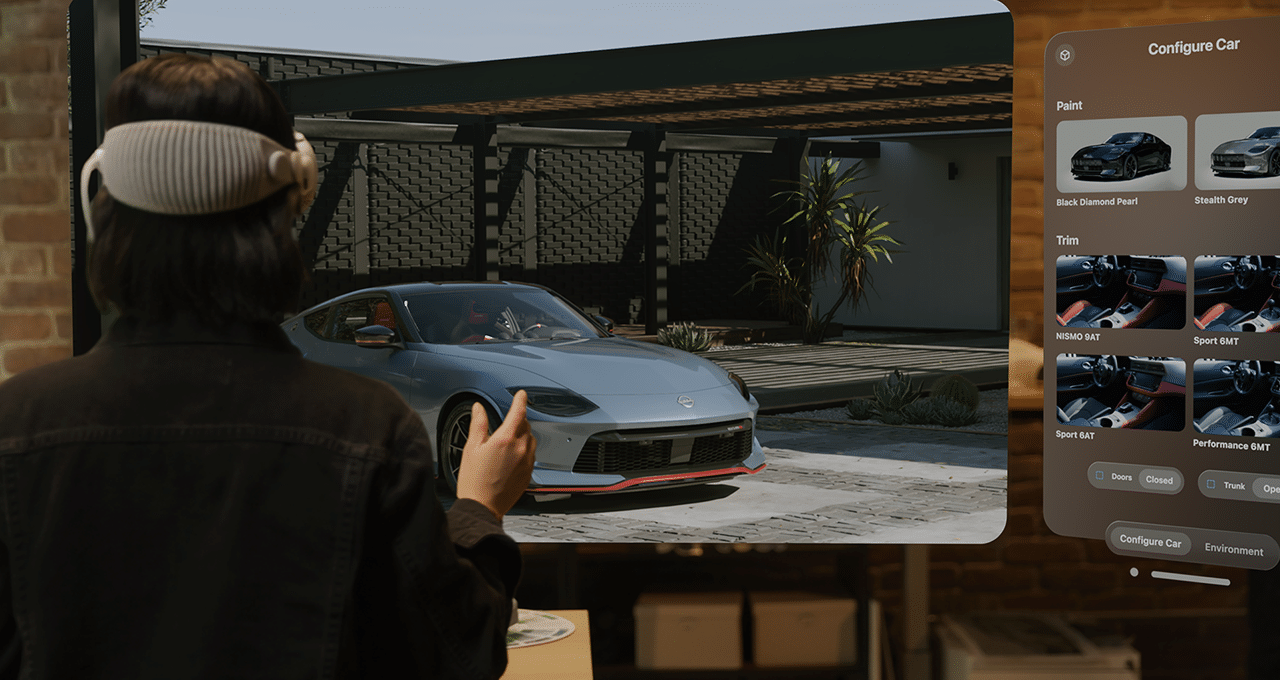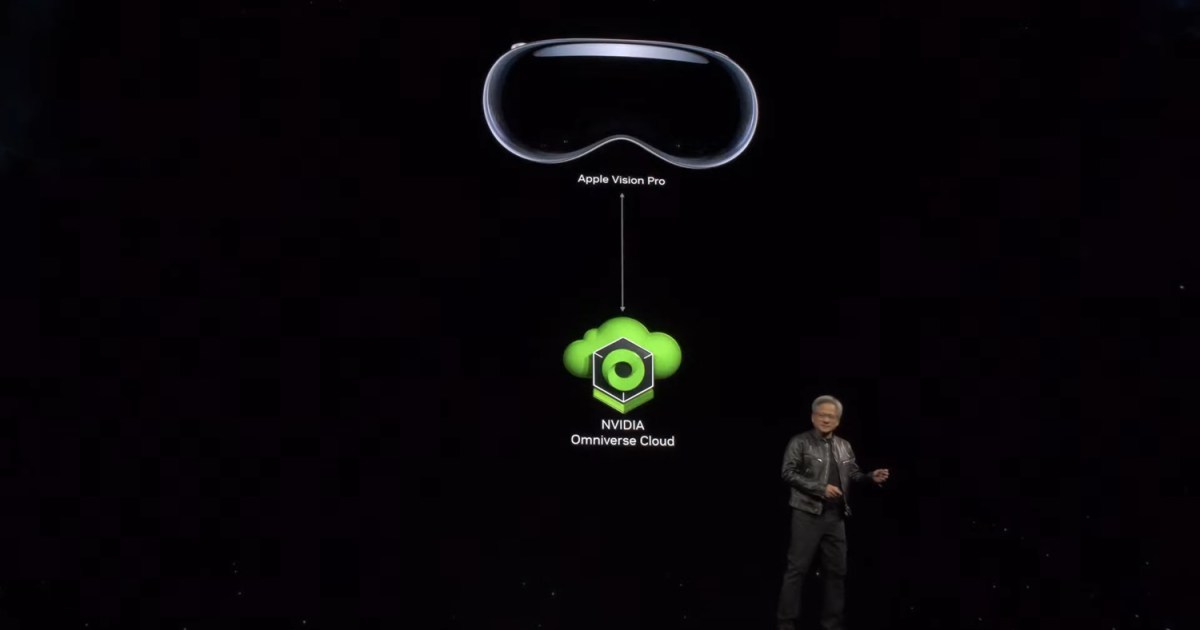- Vision Quest
- Posts
- This Week in Tech 012
This Week in Tech 012
If You Haven't Been Paying Attention...NVIDIA is WINNING!!!!
NVIDIA continues to lead the charge into the future and they’re bringing Apple along for the ride
NVIDIA and Apple are joining forces, meshing the Omniverse with Apple Vision Pro to craft immersive digital twins. It's the stuff of tech legend, transforming industrial scenes into virtual masterpieces right before your high-res goggled eyes.
Flat2VR Studios is bursting onto the scene, flipping 2D games into VR marvels. Think of your all-time favorites getting a VR makeover that's so immersive, you’ll forget which reality you're in.
On the AI front, NVIDIA’s unleashing its Blackwell chips, sparking an AI revolution that’s making everything from cloud computing to humanoid robots smarter, faster, and more connected than ever. And Apple? They’re weaving AI into the iPhone fabric with potential assists from Google and OpenAI, hinting at a future where your phone’s smarter than a room full of geniuses.
Leading the digital twin charge, Singapore's showcasing a virtual replica so precise, it'll make urban planners and architects weep with joy. From buildings to entire cities, digital twins are paving the way for a smarter, more sustainable future that's as ambitious as it is innovative.
So, keep your gadgets close and your imagination closer. The future’s not just knocking; it’s blowing the door off its hinges, ready to whisk us away to a world where the line between digital and reality is brilliantly, wonderfully blurred.
What you'll read today
The Metaverse and Spatial Computing
Apple Vision Pro & NVIDIA
NVIDIA's recent announcement at the NVIDIA GTC about integrating Omniverse enterprise digital twins with Apple Vision Pro marks a significant leap towards enriching spatial computing and the metaverse. By leveraging Omniverse Cloud APIs, developers can now stream Universal Scene Description (OpenUSD) industrial scenes directly to Apple Vision Pro through NVIDIA's Graphics Delivery Network (GDN).
This integration combines NVIDIA's RTX cloud rendering and Apple Vision Pro’s ultra-high-resolution displays to deliver immersive, high-fidelity visual experiences directly to the user's Vision Pro headset.
Read More:
Flat2VR Studios
Flat2VR Studios, a new gaming studio formed by Impact Reality, is focusing on developing officially licensed VR ports of flatscreen games. Leveraging the expertise of established VR modders from the Flat2VR community, such as Team Beef, Cabalistic, and Raicuparta, the studio aims to transform beloved traditional video games into immersive VR experiences.
Their mission is to meet the growing demand for experiencing classic games in VR, offering high-quality versions directly on VR storefronts like Meta Quest, PlayStation VR2, and Steam. The studio has announced that their first licensed VR game is in development, with a release targeted for late 2024 or early 2025, although details of the game remain undisclosed.
Apple Vision Pro App Store
Now you can finally see the apps available on the headset without buying one. This could be a big way to expose the various applications that exist in the Vision Pro and help boost awareness and sales.
It could also be a benefit for developers helping them get their work noticed and potentially recognized as the “killer app” that entices people to buy the product.
Artificial Intelligence
Nvidia CEO Jensen Huang kicks off its GTC keynote in San Jose with a slew of AI infused chip announcements
The Nvidia 2024 AI Event video provides a comprehensive overview of Nvidia's latest advancements and strategic partnerships in AI technology, focusing on their new platforms, chips, and collaborations with major tech companies.
Here are the key points and insights from the event:
Introduction of Blackwell Platform
Nvidia unveiled the Blackwell platform, emphasizing that Nvidia's GPUs have evolved significantly. The Blackwell chip features a groundbreaking design that allows two dies to work seamlessly as one, eliminating memory locality and cache issues. This design enables an impressive 10 terabytes per second data transfer between the dies.
Hopper and Blackwell Chips
The Hopper chip, with 28 billion transistors, set the stage for Blackwell's innovation. Blackwell is compatible with existing Hopper installations, facilitating efficient upgrades due to identical infrastructure requirements.
MVY Link Switch
A new chip called the MVY Link Switch was introduced, boasting 50 billion transistors. It enables high-speed communication between GPUs, allowing for unprecedented computational power in AI systems.
Partnerships and Integrations
Nvidia announced partnerships with AWS, Google Cloud Platform (GCP), Oracle, Microsoft, and others. These collaborations aim to leverage Nvidia's AI technology across various services, including cloud computing, AI model training, and more. Notably, AWS is preparing to build a 2 exaflops system with Nvidia, and Google is optimizing its services with Nvidia GPUs.
Nvidia AI Foundry
Nvidia introduced the AI Foundry, likening its role in AI to TSMC's in chip manufacturing. The Foundry will offer pre-trained AI models and optimization tools for various Nvidia platforms, aiming to simplify and accelerate AI deployment across industries.
Collaborations with Enterprises
Nvidia is working with SAP, ServiceNow, Cohesity, Snowflake, NetApp, and Dell to integrate AI capabilities into their services and products. These collaborations highlight Nvidia's commitment to enabling AI across a wide range of business applications.
Omniverse and Robotics
Nvidia discussed its Omniverse platform, a virtual environment for creating digital twins and training AI models. They also introduced Project Groot, a foundation model for humanoid robot learning, and Jetson Thor, a new chip designed for robotics applications.
Disney Collaboration
The event featured a demonstration with Disney's BDX robots, showcasing the practical application of Nvidia's robotics technology.
This event underscored Nvidia's strategic direction towards integrating AI and machine learning more deeply into various sectors, emphasizing the importance of partnerships, advanced computing platforms, and the role of AI in future technologies. Nvidia's advancements in chip technology, particularly with the Blackwell platform and MVY Link Switch, highlight their commitment to pushing the boundaries of AI and computational capabilities.
OpenAI & Figure Partnership Update
With OpenAI, Figure 01 can now have full conversations with people
-OpenAI models provide high-level visual and language intelligence
-Figure neural networks deliver fast, low-level, dexterous robot actionsEverything in this video is a neural network:
— Figure (@Figure_robot)
2:00 PM • Mar 13, 2024
OpenAI's partnership with FigureAI in developing a humanoid robot signifies a major leap towards integrating advanced artificial intelligence into everyday life. This collaboration could revolutionize various sectors, including healthcare, manufacturing, and customer service, by providing highly efficient, intelligent robotic assistance.
For society, it promises significant improvements in productivity, safety, and accessibility, potentially transforming how tasks are performed and services are delivered. However, it also raises important questions about employment, privacy, and ethical AI use, necessitating careful consideration and regulation.
Apple’s Potential AI Partnerships
Apple is in talks with Google to integrate Gemini generative AI into the iPhone and has considered using OpenAI's ChatGPT. CEO Tim Cook announced plans to introduce AI features later this year, potentially blending Apple's on-device AI with third-party cloud-based AI through partnerships. Samsung and Google already collaborate on AI for Galaxy phones, and Google's AI features on its Pixel devices.
Apple's existing agreement with Google, worth $18 billion annually, positions Google Search as the default on Apple devices, despite regulatory scrutiny. A deal could bring Google's AI to over 2 billion iPhones, but suggests Apple's AI may not be as advanced, with in-house projects like Apple GPT and Ajax reportedly lagging behind competitors. Any potential AI partnership with Google might not be confirmed until after WWDC in June.
Send your AI Clone to Job Interviews
High signal to noise ratio
Send your AI clone to take job interviews…
— Linus ●ᴗ● Ekenstam (@LinusEkenstam)
1:05 PM • Mar 19, 2024
Digital Twins
Constructing the Virtual & Physical Together
Digital Twins in construction optimize traditional processes, offering efficiency, cost savings, and deep insights into building design, construction, and maintenance. By creating virtual replicas of physical buildings, these advanced models enable virtual experimentation, risk management, and resource optimization.
Future applications include integrated lifecycle management and city-wide planning, promising smarter, more sustainable, and resilient infrastructure. Digital Twins are reshaping the construction sector, pointing towards a future of enhanced innovation and environmental stewardship.
The Future of Singapore is Digital - read more
Digital twins are revolutionizing Singapore's approach to urban planning and manufacturing, contributing significantly to its GDP. These virtual replicas, powered by IoT, machine learning, and real-time data, enable precise simulations of physical objects and environments, from individual vehicles to entire cities. This technology allows for detailed analysis and decision-making, enhancing efficiency, reducing maintenance costs, and improving design processes.
As Singapore advances its smart nation initiative, digital twins play a pivotal role in shaping a future of optimized infrastructure, innovative manufacturing, and sustainable urban development .
Something Extra
Lazareth LMV 496 a flying electric motorbike.
What do you think?
— Science girl (@gunsnrosesgirl3)
12:12 PM • Mar 18, 2024
There is a new 'Squirrel With a Gun' trailer
— Dexerto (@Dexerto)
7:00 PM • Mar 18, 2024
How did you like this week's edition? |





/cdn.vox-cdn.com/uploads/chorus_asset/file/24931975/236794_iPhone_15_pro_pro_Max_VPavic_0019.jpg)

